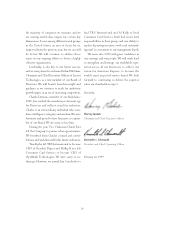American Express 1998 Annual Report Download - page 24
Download and view the complete annual report
Please find page 24 of the 1998 American Express annual report below. You can navigate through the pages in the report by either clicking on the pages listed below, or by using the keyword search tool below to find specific information within the annual report.
1998 was another solid year for American Express
Company (the Company). We posted strong financial
results and made further progress on our strategies,
notwithstanding the difficult economic environments in
many areas and volatile financial markets. We prudently
deployed capital through strategic acquisitions that helped
strengthen our competitive position in a number of busi-
nesses, successfully launched card products outside the
United States and partnered with other institutions to
issue cards on our network. At the core of our perfor-
mance is a determined focus on three basic operating
principles: offering superior value to customers, continu-
ally driving toward best-in-class economics and building
the American Express brand.
The Company reported record 1998 net income of
$2.14 billion, 8 percent higher than net income of
$1.99 billion in 1997. The 1998 results include several first
quarter items: a $138 million (after-tax) credit loss provi-
sion at American Express Bank (AEB) relating to its
Asia/Pacific portfolio, as well as income in the Corporate
segment of $78 million (after-tax) representing gains on
the sale of First Data Corporation (FDC) shares and a pre-
ferred dividend based on Lehman Brothers’ earnings.
Excluding these items, 1998 income was $2.2 billion, an
increase of 11%. In 1996, operating income was $1.74 bil-
lion, excluding two fourth quarter items: a $300 million
(after-tax) gain on the exchange of Debt Exchangeable for
Common Stock (DECS) for shares of common stock of
FDC and a $138 million (after-tax) restructuring charge.
The Company’s 1998 results were in line with its long-term
targets of achieving, on average and over time: 12-15 per-
cent earnings per share growth and at least 8 percent growth
in revenues, but were at the low end of the range. Return
on equity exceeded the Company’s long-term target of
18-20 percent.
Diluted earnings per share were $4.63, $4.15 and
$3.89 in 1998, 1997 and 1996, respectively. After adjust-
ing 1998 for the above-mentioned AEB credit loss
provision and the Corporate gains and after adjusting 1996
for the restructuring charge and the DECS gain, diluted
earnings per share were $4.76, $4.15 and $3.56 in 1998,
1997 and 1996, respectively. On this basis, 1998 earnings
per share rose 15%. The rise in adjusted earnings per share
for 1998 and 1997 reflects revenue growth, margin
improvement and a reduction in average shares outstanding.
Consolidated revenues rose 7.7 percent in 1998 to
$19.1 billion, compared with $17.8 billion and $16.4 bil-
lion in 1997 and 1996, respectively. Revenues, net of
American Express Financial Advisors’ provisions for losses
and benefits, rose 8.3 percent and 9.2 percent in 1998 and
1997, respectively. Contributing to both years’ results were
increases in worldwide billed business, higher management
and distribution fees and greater loans outstanding and
interest margins in Cardmember lending. Growth in 1998
was also enhanced by travel acquisitions.
YEAR 2000
The Year 2000 (Y2K) issue is the result of computer pro-
grams having been written using two digits rather than four
to define a year. Some programs may recognize a date using
“00” as the year 1900 rather than 2000. This misinter-
pretation could result in the failure of major systems or
miscalculations, which could have a material impact on the
Company and its businesses or subsidiaries through busi-
ness interruption or shutdown, financial loss, reputational
damage and legal liability to third parties. The Company
began addressing the Y2K issue in 1995 and has estab-
lished a plan for resolution, which involves the remediation,
decommissioning and replacement of relevant systems,
including mainframe, mid-range and desktop computers,
application software, operating systems, systems software,
date back-up archival and retrieval services, telephone and
other communications systems, and hardware peripherals
and facilities dependent on embedded technology. As a
part of our plan, we have generally followed and utilized
the specific policies and guidelines established by the
Federal Financial Institutions Examination Council, as well
as other U.S. and international regulatory agencies.
Additionally, we continue to participate in Y2K related
industry consortia sponsored by various partners and sup-
pliers. Progress is reviewed regularly with the Company’s
senior management and Board of Directors.
Our Y2K compliance effort related to information
technology (IT) systems is divided into two initiatives. The
first, which is the much larger initiative, is known internally
as “Millenniax,” and relates to mainframe and other tech-
nological systems maintained by the American Express
Technologies organization (AET). The second, known as
“Business T,” relates to the technological assets that are
owned, managed or maintained by the Company’s individ-
ual business units. Business T also encompasses the
remediation of non-IT systems. These initiatives involve a
substantial number of employees and external consultants.
This multiple sourcing approach is intended to mitigate
the risk of becoming dependent on any one vendor or
resource. While the vast majority of our systems that
require modification are being remediated, in some cases
we have chosen to migrate to new applications that are
already Y2K compliant.
The Company’s plans for remediation with respect
to Millenniax and Business T include the following pro-
gram phases: (i) employee awareness and mobilization,
(ii) inventory collection and assessment, (iii) impact
analysis, (iv) remediation/decommission, (v) testing and
(vi) implementation. As part of the first three phases,
we have identified the Company’s mission-critical sys-
tems for purposes of prioritization. The Company’s
goals are to complete testing of critical systems by early
1999, and to continue compliance efforts, including but
not limited to, the testing of systems on an integrated
basis and independent validation of such testing,
FINANCIAL REVIEW
CONSOLIDATED RESULTS OF OPERATIONS
22
























